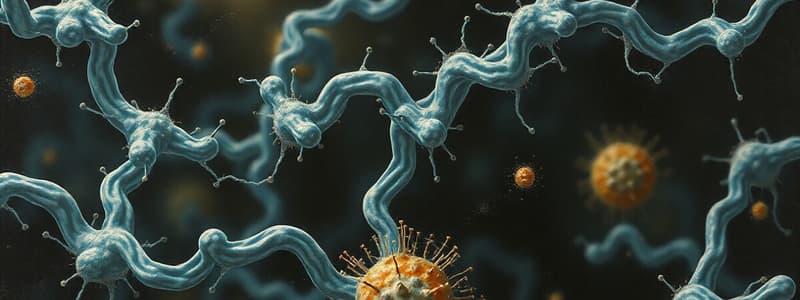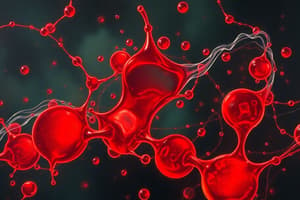Podcast
Questions and Answers
Which of the following processes requires energy to move substances across a cell membrane?
Which of the following processes requires energy to move substances across a cell membrane?
- Facilitated diffusion
- Diffusion
- Osmosis
- Active transport (correct)
All living organisms can be classified into two main groups: prokaryotes and eukaryotes.
All living organisms can be classified into two main groups: prokaryotes and eukaryotes.
True (A)
What is the main purpose of enzymes in biological processes?
What is the main purpose of enzymes in biological processes?
They catalyze chemical reactions.
In the process of ______, water moves across the cell membrane from an area of low solute concentration to an area of high solute concentration.
In the process of ______, water moves across the cell membrane from an area of low solute concentration to an area of high solute concentration.
Match the following characteristics with their descriptions:
Match the following characteristics with their descriptions:
Which of the following describes osmosis?
Which of the following describes osmosis?
Active transport occurs naturally and does not require energy.
Active transport occurs naturally and does not require energy.
What is the primary factor that differentiates prokaryotic cells from eukaryotic cells?
What is the primary factor that differentiates prokaryotic cells from eukaryotic cells?
____________ is a process by which molecules move from an area of high concentration to an area of low concentration.
____________ is a process by which molecules move from an area of high concentration to an area of low concentration.
Match the following types of transport with their characteristics:
Match the following types of transport with their characteristics:
Flashcards are hidden until you start studying
Study Notes
Enzymes
- Biological catalysts that speed up chemical reactions
- Highly specific to their substrates
- Function by lowering activation energy
- Examples: amylase breaks down starch, protease breaks down proteins, lipase breaks down fats
Movement in and out of Cells
- Diffusion: Passive movement of molecules from high concentration to low concentration
- Osmosis: Diffusion of water across a selectively permeable membrane
- Active transport: Movement of molecules against their concentration gradient, requiring energy
Characteristics and Classification of Living Organisms
- All living things share fundamental characteristics:
- Organization
- Metabolism
- Growth
- Adaptation
- Response to stimuli
- Reproduction
- Classification Systems:
- Taxonomy: Hierarchy for organizing living organisms based on shared characteristics
- Domain, Kingdom, Phylum, Class, Order, Family, Genus, Species
- Phylogenetic Tree: Shows evolutionary relationships between organisms
- Taxonomy: Hierarchy for organizing living organisms based on shared characteristics
Features of Organisms
- Organisms are diverse in form and function
- Classified into distinct groups:
- Prokaryotes: Single-celled organisms without a nucleus (bacteria and archaea)
- Eukaryotes: Organisms with a nucleus and membrane-bound organelles (plants, animals, fungi, protists)
Organization of the Organism
- Cellular level: Basic building block of life
- Tissue level: Groups of similar cells working together
- Organ level: Different tissues working together for a specific function
- Organ system level: Groups of organs working together
- Organism level: All organ systems working together to form a complete living being
Enzymes
- Biological catalysts that speed up chemical reactions in living organisms
- Highly specific, only catalyzing one or a few reactions
- Lower activation energy of reactions, making them occur faster
- Work in specific conditions, being sensitive to pH, temperature, and substrate concentration.
- Examples include amylase breaking down starch into simpler sugars, and lipase breaking down fats (lipids) into fatty acids and glycerol.
Movement in and out of Cells
- Diffusion: Movement of a substance from an area of high concentration to low concentration, to reach equilibrium.
- Osmosis: Movement of water molecules from an area of high water potential to low water potential across a selectively permeable membrane, also to reach equilibrium.
- Active Transport: Movement of molecules against a concentration gradient, requiring energy from the cell.
Characteristics and Classification of Living Organisms
- Seven characteristics of living organisms:
- Movement: Respond to stimuli in their environment
- Respiration: Release energy from food
- Sensitivity: Respond to stimuli in their environment
- Growth: Increase in size and complexity
- Reproduction: Create new organisms of the same species
- Nutrition: Take in and utilize nutrients from the environment
- Excretion: Removal of waste products from the body
- Classification Systems: Used to organize living organisms into groups based on shared characteristics.
- Taxonomy: The scientific study of naming, defining, and classifying organisms.
- Binomial Nomenclature: A system of naming species with a two-part name, consisting of the genus and the species.
Concept and Uses of Classification Systems
- Hierarchical System: Organizes living things into groups based on shared similarities.
- Kingdom, Phylum, Class, Order, Family Genus, Species: Levels of classification, starting with the broadest (kingdom) and becoming increasingly specific.
- Phylogenetic Trees: Illustrate the evolutionary relationships between organisms.
- Uses of Classification Systems:
- Organization and identification: Helps understand the relationships between different species.
- Communication: Provides a universal language for scientists to communicate about organisms.
- Conservation: Helps identify and protect endangered species.
Features of Organisms
- Cells: Basic units of life, each with specific structures performing different functions.
- Tissues: Groups of similar cells working together to perform a specific function.
- Organs: Composed of different tissues working together to perform a specific function.
- Organ Systems: Composed of different organs working together to perform a specific function.
- Systems of organs: Digestive, circulatory, respiratory, nervous, excretory, reproductive, and skeletal systems.
Organization of the Organism
- Cellular Level: Individual cells, with their characteristic structures and functions.
- Tissue Level: Groups of similar cells, like muscle tissue, nervous tissue, and epithelial tissue.
- Organ level: Groups of different tissues working together, such as the stomach, lungs, and brain.
- Organ System Level: Groups of organs working together to perform a function, such as the digestive system, which breaks down food.
- Organism Level: Complete living being.
Studying That Suits You
Use AI to generate personalized quizzes and flashcards to suit your learning preferences.




